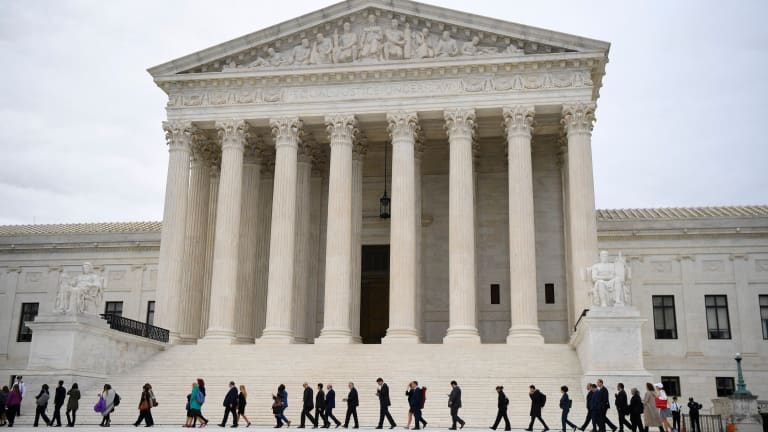
Mr. CFB: Did SCOTUS Tell The NCAA That The Party Is Over?

I’m not lawyer but I did help raise one. And if there is one lesson to be learned as the parent of a lawyer it is this: If you get slammed-dunked 9-0 by the Supreme Court of the United States, you’ve just gotten your legal butt royally kicked.
That is the position that the National Collegiate Athletic Association finds itself in today. Yes, the court’s 9-0 ruling was narrow in scope in that it told the NCAA it could no longer put a cap on the educational benefits of an athletic scholarship.
But you don’t have to be a lawyer to understand that the real message that SCOTUS sent to the NCAA was much bigger:
The party’s over.
“The NCAA’s business model would be flatly illegal in almost any other industry America,” wrote Justice Brett Kavanaugh in a concurring opinion.
“The NCAA and its member colleges maintain important traditions that have become part of the fabric of America. But those traditions alone cannot justify the NCAA’s decision to build a massive money-raising enterprise on the backs of student athletes who are not fairly compensated.”
Do you get the feeling that the Justice was writing about more than just the educational component of an athletic scholarship? His opinion reads like something that is much, much bigger.
Then Justice Kavanaugh brought the hammer down:
“Nowhere else in America can businesses get away with agreeing not to pay their workers a fair market rate on the theory that their product is defined by not paying their workers a fair market rate. And under ordinary principles of anti-trust law, it is not evident why college sports should be any different.
“The NCAA is not above the law.”
Boom!
The Supreme Court’s ruling sent shock waves throughout the industry that is college athletics—not for what it did but for what could happen down the road.
“The cartel is dead,” said Vince Thompson, president and CEO of MELT, one of the top sports marketing firms in the United States. “The NCAA as we know it is broken and I don’t know how you put the pieces back together.”
ESPN basketball analyst Jay Bilas, who is a lawyer and has long advocated for more financial opportunity for college athletes, said Tuesday that he wasn’t surprised by the court’s 9-0 ruling.
“But I was surprised at how far the court went in undressing the NCAA,” Bilas said during an appearance on ESPNU radio. (The court said) “Your policies are not good. Stop doing that. Allow the players to compete for the dollars everyone else does.”
There was another message sent to the NCAA by the Court. Without question Monday’s ruling, which came on a suit brought by former college athletes, opens the door for future lawsuits over the issue of compensation. SCOTUS pretty much told the NCAA that without an anti-trust exemption from Congress, the players are likely to prevail in those lawsuits. And that could get REALLY messy.
“This,” said Thompson, “Is just the beginning.”
The irony of the ruling is that the last time the NCAA went before the Supreme Court it lost—big. In 1984 the Supreme Court ruled that the individual schools, and not the NCAA, owned the television rights for college football. The case—The NCAA vs. Board of Regents—opened the flood gates to the incredible amount of college football on television today and the incredible amount of dollars that came with it.
In that case the NCAA argued that if it were not in charge of television rights people would stop going to games. Two schools—Oklahoma and Georgia—argued just the opposite. They were right. Today televised college football is a billion-dollar industry where coaches are paid millions and schools have spent additional millions on state-of-the art facilities to entice recruits.
But the compensation to the players remains limited to room, board, books, tuition, fees and a cost of attendance stipend. It’s not nothing but it isn’t the life-changing money that the adults who run the sport enjoy.
The landscape on that front may change soon as the NCAA is expected to announce rules that would allow athletes to be compensated by private companies for the use of their name, image, or likeness.
How it is going to work and what guardrails may be in place is anybody’s guess. The NCAA has until July 1 to come up with a plan. After that several states, including Georgia, Florida, Alabama, Mississippi, Louisiana and Texas, will implement their own NIL laws.
The thinking here is that the whole NIL concept will be a mess for a while. But it will be a mess where the benefits accrue to the players.
But the fact is that the NCAA, a sports empire built on the concept of amateurism, must now admit its days of operating under the current system are numbered.
One last word from Justice Kavanaugh:
“The NCAA has long restricted the compensation and benefits that student athletes may receive. The Court’s decision marks an important overdue course correction. I add this concurring opinion to underscore that the NCAA’s remaining compensation rules also raise serious questions under the antitrust laws.”
Stay tuned.